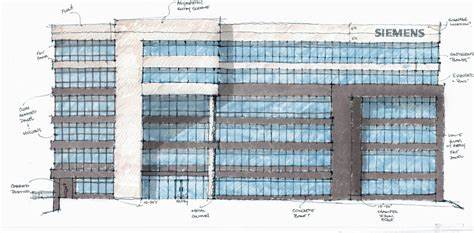Looking at a stack of plans can often be confusing to someone who isn’t accustomed to a set of construction documents. A building or interior space that is a complex piece of workmanship may not be communicated the best through plans, elevations, and sections when shown to clients. With that said, a rendering can be quite valuable in those situations. In this blog, we’ll discuss the benefits of 3D renderings, different types and when to use them.
The Benefits of 3D
A rendering from 3D modeling software can help provide a better sense of scale that a set of plans simply doesn’t offer. In the schematic phase, there are usually many concepts for a project. By using 3D modeling software, it enables you to quickly look at several concepts from any angle. It’s very easy to push and pull surfaces, mass out shapes, or generally bring the project to life. It’s also great to use for meetings, easily distribute to anyone who couldn’t attend a meeting, or use as a talking point throughout the design process. We’ll discuss two different renderings that we use pretty frequently, sketched and photorealistic.
Sketched Renderings
Beauty remains in sketched renderings. The feeling of freedom it provides knowing that things aren’t permanent yet, keeps folks engaged in the design process. Maybe that soffit feels too heavy when you see it modeled, or maybe the change in flooring materials looks too busy. Sketching is a great time to really think outside the box and lay out your ideas without any penalty.
When to Use
Sketchier renderings work best as a concept tool. Sometimes it’s difficult to get a good read on the colors and materials, or the way the exterior light will interface in a space with a sketched rendering. Once the scale, balance, and general feel of the space are agreed upon, then additional shortcomings can be addressed in the next level of rendering.
Photorealistic Renderings
As the design begins to be finalized, a more photorealistic rendering is likely the next step for the key impact spaces of the project. These can give the client a better sense of their project than say, a physical model, and in a fraction of the time. Keep in mind that lighting can be tricky – both interior and exterior with these photorealistic images. For example, the tile you saw in the design library might read a little differently in the rendering. However, a photorealistic rendering is great for showing building façade materials, wall and floor finishes, even the surrounding environment in a very realistic manner.
When to Use
These renderings are great for getting your employees excited about what’s to come or for attracting potential tenants to your spec building. They are often used in press releases, web pages or billboards on the job site. Just remember, you want to be pretty locked into the design before you distribute a rendering of this detail.
Overall
While there are various degrees of “finality” to a 3D rendering, it is a key tool to developing better communication between you and your clients, creating accessibility to the design for stakeholders in a project, and generating excitement about the design of a space.



